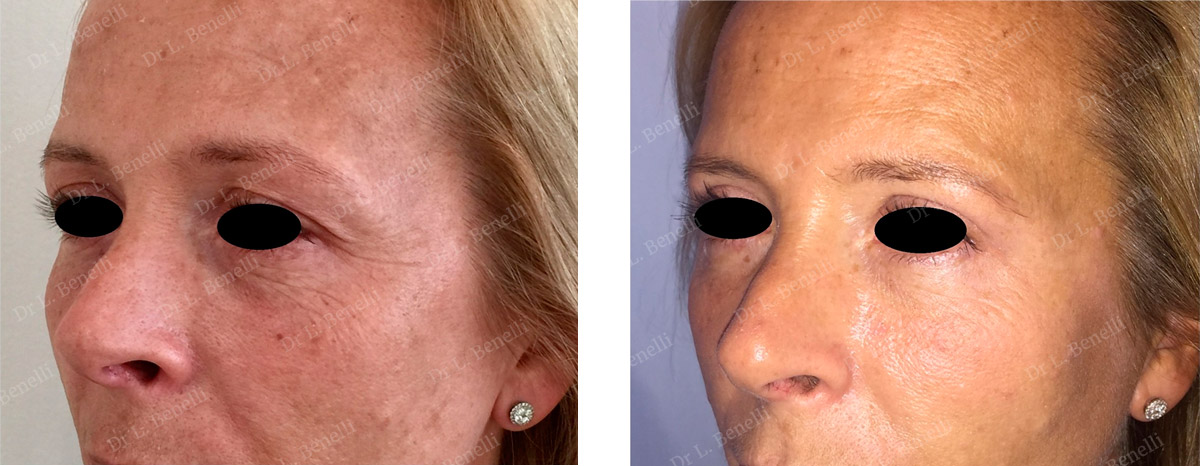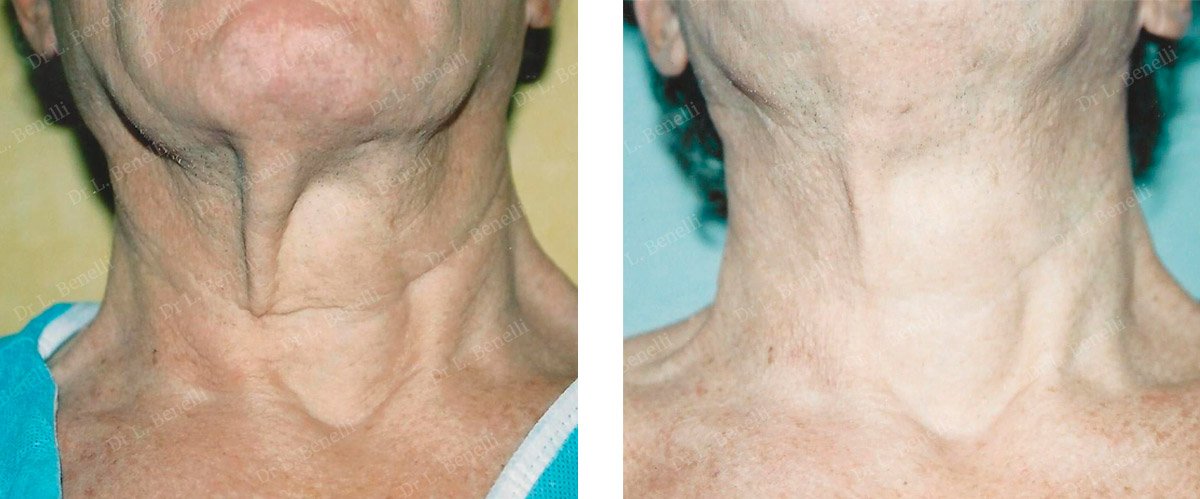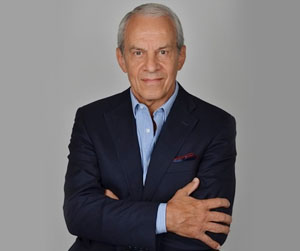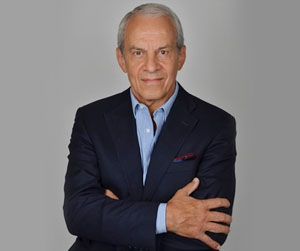The Curl-lift (tension wires)
The Curl-lift technique uses tension wires to enhance sagging areas of the face and neck. The Curl-lift can be performed on 5 locations:
-
The temporal Curl-lift raises the external part of the eyebrow and the upper eyelid.
-
The frontal curl-lift raises the whole eyebrow and forehead.
-
The malar curl-lift lifts the cheekbone and corrects malar bags, which are swellings located under the fatty pockets of the lower eyelid.
-
The cheek curl-lift raises the cheeks and jowls.
-
The cervical curl-lift redefines the cervico-facial angle by correcting sagging neck skin and possibly a double chin.
The aim of this technique is to enhance the position of the tissues with a fast intervention under local anaesthesia and without hospitalisation, leaving little swelling and bruising. There is no scar and you can quickly resume your social life.
This does not change anatomical structures but simply repositions them as they were a few years ago, maintaining a very natural appearance while toning sagging facial contours.
The result is not as effective as that of a facelift but this technique can be used according to your expectations and the level of tissue sagging.
The objective is not to correct sagging completely but to reduce it so that the whole face is harmonious and toned, while preserving your identity.

Upper eyelid plastic surgery, combined with a temporal Curl-Lift (tension wires) to raise eyebrow sagging

Cervical curl-lift without a scar. Result after 1 year.
Uses
This technique is still little known by the general public but sagging facial tissues is one of the most frequent reasons for seeking a consultation. Then, a curl-lift can be recommended either as a single treatment or combined with another procedure to give a more complete result and improve facial harmony. This will be assessed during the first consultation.
A curl-lift is used when sagging is not too significant and you want a basic improvement but without completely correcting the problem.
The improvements obtained are satisfactory but this procedure is not as spectacular as a complete facelift with extensive skin detachment, muscle repositioning, skin re-tensioning and removal of the excess.
So, depending on the circumstances, it may be better to use the lifting technique or a curl-lift with another procedure at the same time, such as:
-
eyelid plastic surgery,
-
lipomodelling, with liposuction of fat deposits (double chin, jowls, Bichat fat ball), and/or by liposuction (injecting your own fatty tissue) to correct some areas of wrinkles and restore volume to sagging areas,
-
Injecting hyaluronic acid or botox to reduce areas of wrinkles,
-
Chemical or laser peels.
A temporal curl-lift raises the outer part of the eyebrow and the upper eyelid.
The external part of the eyebrow must be above the orbital bone arch or at least at the same level. If the outer part of the eyebrow is below the arch, this aggravates the appearance of drooping eyes, which may be further accentuated by retreating skin on the upper eyelid. For this, upper eyelid plastic surgery will be required, lifting the external part of the eyebrow. The scars are only 2 millimetres in size and are hidden in the scalp, without causing any hair loss.
If the entire forehead is sagging, a full frontal curl-lift can be performed to raise not only the eyebrows but also the entire forehead.
The malar curl-lift lifts the cheekbone and corrects malar bags, which are swellings located under the fatty pockets of the lower eyelid. These malar bags, like the bags under the eyes, inflate or deflate according to the lifestyle you are leading at any given time (lack of sleep, excess food or alcohol, tobacco, stress...). When they are permanent, despite a balanced lifestyle, you can correct them with a curl-lift, possibly combined with lower eyelid plastic surgery. Simultaneously enhancing the eyelid and cheekbone makes it possible to obtain a more balanced and natural result, the correction of a single defect making it all the more likely that another defect in the same anatomical zone is accentuated.
The cheek curl-lift raises the cheeks and jowls. It is often used with lipomodelling and liposuction of the fatty excess (double chin, jowls, fatty Bichat ball) and with a cervical curl-lift to tighten the skin around the neck as the jowls often descend towards the neck region.
The cervical curl-lift redefines the cervico-facial angle by correcting sagging neck skin and possibly a double chin, completed with lipomodelling through liposuction of the double chin and jowl.
Consultation
During the first consultation, it is essential that you openly express what bothers you and what you would like to improve. Do not be afraid to ask any questions, including expressing your fears and expectations. Everyone has a different body shape, psychology and expectations. These are not the same and there is no standard to apply.
After you have explained your motivations, I will examine you and offer one or more solutions, taking into account your expectations, your anatomy, respecting your identity and the naturalness of your appearance.
So you can visualise the desired result, I will show you photos of surgical results from cases similar to yours to enable you to understand the objective of the intervention. It is essential that you and I have a good understanding when deciding to operate and to determine the technique to use from among those I can offer.
I will then give you all the information on the techniques offered and give you a detailed estimate of the costs according to the options chosen. This will allow you to take your project forward and prepare for a second consultation, during which you will be able to ask any additional questions, allowing you to make a decision and prepare for the procedure.
Before the procedure
No special examination is required.
It may be necessary to carry out a blood test, depending on the type of anaesthetic (local or general).
Recommendations
No medication containing aspirin or anti-inflammatories may be taken within 10 days of the procedure.
With local anaesthetic, it is recommended that you drink and eat lightly at regular meal times before treatment.
The procedure
Hospitalisation and the duration of the procedure
A curl-lift can be carried out at the doctor's clinic without hospitalisation.
The duration of the operation is about 30 minutes; then, you can go home after a short period of rest.
Type of anaesthetic
Local, deep local (neuroleptanalgesia), or general, depending on the patient’s preference. If you have a general anaesthesia, a half-day hospital stay is compulsory and a consultation with the anaesthetist is necessary in the weeks preceding the operation and at least 48 hours before.
Technique
Before the operation, I will draw marks on your skin to guide the operation and the incisions. I will go over the exact objective with you as we agreed during the consultations. You can then always make recommendations or ask any questions.
After anaesthesia, the threads are deployed from the fixed points:
-
From the temple for the face: the incisions are only 2 millimetres and are hidden in the scalp, without causing any hair loss.
-
The fold behind the ear for the neck: the incisions are also 2 mm.
The threads are passed through the loose, soft areas using a grommet and they are mobilised when tightened on the way back at their fixed starting point. The structure of the new tension wires is designed to anchor them better in the soft tissue, providing more stable results.
The stitches in the incisions use just a single stitch, made with a very fine absorbable thread that does not require removal.
At the end of the operation, a slightly compressive bandage is applied and this must be kept until the following day.
After a short rest, you can go home and may just need to wear a simple pair of sunglasses for protection and a scarf around the face to avoid draughts on the operated area.
After the operation
Any pain is very moderate and most of the time there is no need to take pain killers.
What may bother you most is a feeling of tension when moving your face and neck in certain ways, which can last a few days.
There may also be swelling (oedema) or bruising, which varies from case to case and takes a few days to almost completely disappear. It is possible, however, to mask this the day after the operation with suitable make-up designed for post-operative use.
You may need to take 24 hours of time out from social activities and work.
Care
You can remove the dressing yourself 24 hours after the operation. Scars should be cleaned daily with an antiseptic.
As the stitches used are absorbable, they do not need to be removed.
You will need to attend a follow-up visit 3 days after the procedure, then after 15 days, 1 month, 3 months, 6 months, and 1 year.
Recommendations
-
Exposure to the sun: no direct exposure before 1 month then exposure is allowed using a sun protection cream with maximum protection factor.
-
Make-up: any bruises can be hidden by a cover-up cream the day after the operation and your usual make-up can be applied on top of this. The products used must be adapted and designed for post-operative use. They will be prescribed to you on a post-operative prescription.
The result
The area that has been treated is enhanced and more toned. An improvement is immediately visible despite the oedema (swelling) and possible bruises that prevent us from fully judging the final result. After about ten days, progress is sufficient to allow us to appreciate the result, even if this takes 1 to 3 months to stabilise.
In addition to an aesthetic improvement, this operation has a beneficial impact on the patient’s personal well-being and development.
Price range
The cost of the operation will depend on the procedure to be carried out, the duration of the operation, the type of anaesthetic and any hospital charges.
This procedure does not entitle the beneficiary to reimbursement through Social Security.
If the reason for the operation is purely aesthetic, you do not have right to reimbursement by Social Security. On the other hand, if this is for reconstructive purposes after an accident or facial paralysis, you may be covered by the Social Security and, if necessary, by your mutual insurance company.
A detailed estimate is given to you during the first consultation following the options you have chosen. You then have a minimum legal period of 15 days to consider your options and move your project forward.
The first consultation costs €50. The follow-up consultations before and after the operation are free.
The photographs on this page are to illustrate and complete the information given on the operations. They are merely for information purposes so you can see the goals, results and scars from the operation.
The likelihood of scarring and each patient’s individual anatomy are different. For this reason, therefore, the photographs on this site do not commit Dr. Benelli to providing all patients with a similar result.
The information given on a site is not sufficient in itself and a medical consultation is essential to get the right information for each individual case. For this, you will need to consult a surgeon qualified in Plastic Reconstructive and Aesthetic Surgery.



